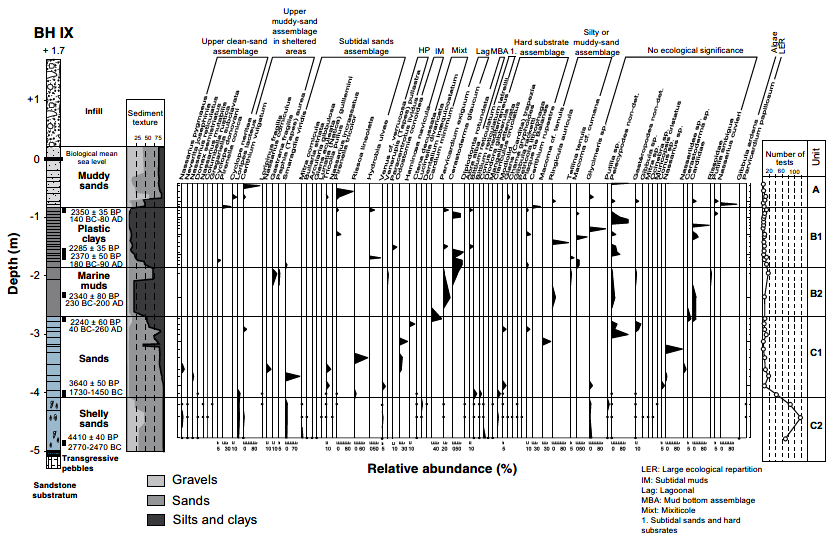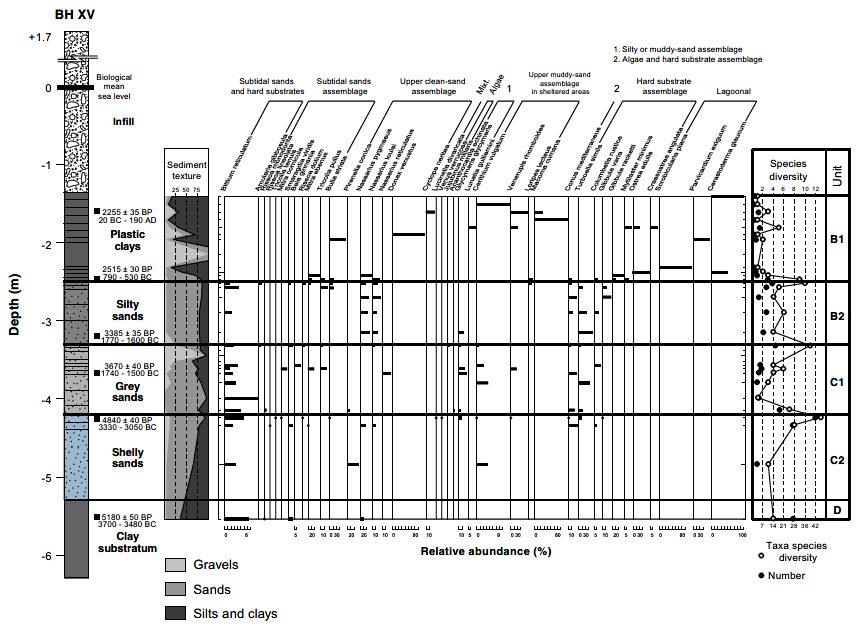Sidon
 Fig. 3
Fig. 3Sidon and Zire (from [31]). In the foreground, Sidon’s outer harbour lies in the shadow zone of Zire island. The promontory of Sidon separates two coves, the northern harbour and Poidebard’s Crique Ronde.
Marriner et al (2006)
| Transliterated Name | Source | Name |
|---|---|---|
| Sidon | English | |
| Sayda | Arabic | صيدا |
| Saida | Modern Arabic | صيدا |
| Ṣaydūn | Classical Arabic | صَيْدونْ |
| Ṣidon | Syriac | ܨܝܕܘܢ |
| Sidṓn | Greek | Σιδών |
| Sidon | Latin | |
| Colonia Aurelia Pia Sidon | Roman colony | |
| Sagittus | Crusader Latin | |
| Saete, Sayette, or Sagette | Crusader French | |
| Ṣīdūn | Phoenician | |
| Djedouna | Papyrus Anastasi I | |
| Ṣīḏōn | Biblical Hebrew | צִידוֹן |
Marriner (2006) provides the following background information
The Sidone-Dakerman area chronicles a long history of human occupation stretching back to the Neolithic [67]. Canaan’s oldest city according to Genesis, the tell occupies a modest rocky promontory that overlooks a partially drowned sandstone ridge and two marine embayments. During the Iron Age, this geomorphological endowment allowed Sidon to evolve into one of Phoenicia’s key city-states, producing and transiting wealthy commodities to trading partners in Assyria, Egypt, Cyprus and the Aegean. This trading ascendancy is corroborated by the Old Testament’s use of the term Sidonian to encapsulate all Phoenicians. Sidon enjoyed its apogee during the sixth to fifth centuries BC, at which time it superseded Tyre as Phoenicia’s principal naval base.Issam Ali Khalifeh in Meyers et al (1997) notes that the historical name for Sidon
is probably derived from sayd, Semitic for fishing.and that
Sidon's history, including the glorious Phoenician period, Assyrian and Persian domination, and Greek and Roman rule, is fairly well known from written sources, local finds, and archaeological work in Sidon and neighboring areas.
- Fig. 2 Sidon’s coastal bathymetry
from Marriner et al (2006)

 Fig. 2
Fig. 2
Sidon’s coastal bathymetry
Marriner et al (2006)
- Fig. 2 Sidon’s coastal bathymetry
from Marriner et al (2006)

 Fig. 2
Fig. 2
Sidon’s coastal bathymetry
Marriner et al (2006)
- Fig. 3 Aerial Photograph of
Sidon and Zire from Marriner et al (2006)

 Fig. 3
Fig. 3
Sidon and Zire (from [31]). In the foreground, Sidon’s outer harbour lies in the shadow zone of Zire island. The promontory of Sidon separates two coves, the northern harbour and Poidebard’s Crique Ronde.
Marriner et al (2006) - Sidon in Google Earth
- Fig. 3 Aerial Photograph of
Sidon and Zire from Marriner et al (2006)

 Fig. 3
Fig. 3
Sidon and Zire (from [31]). In the foreground, Sidon’s outer harbour lies in the shadow zone of Zire island. The promontory of Sidon separates two coves, the northern harbour and Poidebard’s Crique Ronde.
Marriner et al (2006) - Sidon in Google Earth
- Fig. 1 Location of cores
from Marriner et al (2006)

 Fig. 1
Fig. 1
Sidon’s ancient harbour areas and location of cores
Marriner et al (2006)
- Fig. 1 Location of cores
from Marriner et al (2006)

 Fig. 1
Fig. 1
Sidon’s ancient harbour areas and location of cores
Marriner et al (2006)
- Fig. 1.3 Plan of
the inner harbour at Sidon from Raban et al. (2009)

 Figure 1.3
Figure 1.3
Plan of the inner harbour at Sidon
(after Poidebard & Lauffary 1951)
Raban et al. (2009)
- Fig. 1.3 Plan of
the inner harbour at Sidon from Raban et al. (2009)

 Figure 1.3
Figure 1.3
Plan of the inner harbour at Sidon
(after Poidebard & Lauffary 1951)
Raban et al. (2009)
-
Fig. 4 Sedimentology of core BH I
(northern harbour) from Marriner et al (2006)

 Fig. 4
Fig. 4
Sedimentology of core BH I (northern harbour).
Marriner et al (2006) -
Fig. 5 Molluscan macrofauna from
core BH I (northern harbour) from Marriner et al (2006)

 Fig. 5
Fig. 5
Molluscan macrofauna from core BH I (northern harbour).
Marriner et al (2006) -
Fig. 6 Ostracod microfauna
from core BH I (northern harbour) from Marriner et al (2006)

 Fig. 6
Fig. 6
Ostracod microfauna from core BH I (northern harbour)
Marriner et al (2006) -
Fig. 7 Sedimentology of core
BH IX (northern harbour) from Marriner et al (2006)

 Fig. 7
Fig. 7
Sedimentology of core BH IX (northern harbour).
Marriner et al (2006) -
Fig. 8 Molluscan macrofauna
from core BH IX (northern harbour) from Marriner et al (2006)

 Fig. 8
Fig. 8
Molluscan macrofauna from core BH IX (northern harbour).
Marriner et al (2006) -
Fig. 9 Ostracod microfauna
from core BH IX (northern harbour) from Marriner et al (2006)

 Fig. 9
Fig. 9
Ostracod microfauna from core BH IX (northern harbour).
Marriner et al (2006) -
Fig. 10 Sedimentology of
core BH XV (northern harbour) from Marriner et al (2006)

 Fig. 10
Fig. 10
Sedimentology of core BH XV (northern harbour).
Marriner et al (2006) -
Fig. 11 Molluscan macrofauna from
core BH XV (northern harbour) from Marriner et al (2006)

 Fig. 11
Fig. 11
Molluscan macrofauna from core BH XV (northern harbour).
Marriner et al (2006)
Marinner et al (2006) and
Carayon et al (2011) reported on
15 cores taken around the northern harbor and four around the cirque ronde.
There is no mention of tsunamogenic evidence in the cores. Marinner et al (2006:1521) noted that
in Unit B2 (Closed Phoenician to Roman harbours) persistent age-depth anomalies concur analogous data in Tyre’s ancient harbour where strong chronostratigraphic evidence for dredging has
been detailed from the Roman period onwards.
This may indicate that, like at Tyre, any evidence of a 1st millennium BCE tsunami may have been removed by dredging.
Marinner et al (2006) and Carayon et al (2011) reported on 15 cores taken around the northern harbor and four around the cirque ronde. There is no mention of tsunamogenic evidence in the cores.
Carayon, N. and N. Marriner (2011). "Geoarchaeology of Byblos, Tyre, Sidon and Beirut." Rivista di studi fenici XXXIX: 55-66.
Marriner, N., et al. (2006). "Geoarchaeology of Sidon's ancient harbours, Phoenicia." Journal of Archaeological Science 33(11): 1514-1535.
Raban, A., Artzy, M., Goodman, B., and Gal, Z. (eds.) (2009)
The Harbour of Sebastos (Caesarea Maritima) in its Roman Mediterranean Context
, BAR International Series 1930, Archeopress, 222 p.
Chehab, Maurice. "Tombs pheniciennes Majdalouna." Bulletin du
Musee de Beyrouth 4 (1940): 37-53 . Phoenician tombs and their contents in the environs of Sidon.
Contenau, Georges. "Mission Archeologique a Sidon, 1914. " Syria 1
(1920): 198-229, 287-317 . Still a good reference as the first attempt
to excavate in Sidon.
Contenau, Georges. "Deuxieme Mission Archeologique a Sidon,
1920, " Syria 4 (1923): 261-281 ; 5 (1924): 9-23, 123-134 .
Dunand, Maurice. "Rapport preliminaire sur les fouilles de Sidon."
Bulletin du Musee de Beyrouth 19 (1966): 103-105 ; 20 (1967): 27-44;
22 (1969): 101-107 , The primary sources for archaeology atthe site.
Guigues, P, E. "Lebe'a, Kafer-Garra, Qraye: Necropoles de la region
sidonienne." Bulletin du Musee de Beyrouth 1 (1937): 35-76; 2 (1938):
27-72; 3 (1939): 53-63. Useful reference for excavations in the environs of Sidon.
Jidejian, Nina. Sidon through the Ages. Beirut, 1971 . The history of Sidon.
Poidebard, Antoine, and Jean Lauffray. Sidon: Amenagements antiques
du Port de Saida. Beirut, 1951 . The only useful source on the port
excavations.
Renan, Ernest. Mission de Phenicie. Paris, 1864. Pioneering work at the
necropolei of Sidon.
Saidah, Roger. "Chronique fouilles de Sidon." Bulletin du Musee de
Beyrouth 20 (1967): 162-165 .
Saidah, Roger. "Archaeology in the Lebanon, 1968-1969. " Berytus 18
(1969): 119-142 . Covers the archaeological activities in the city itself,
the Temple of Eshmun, the necropolei, and the Chalcolithic settlement.

